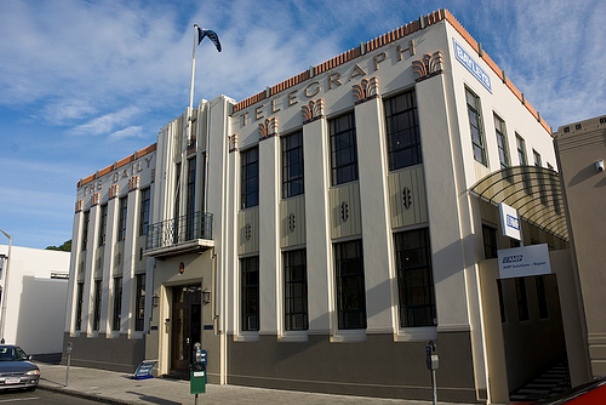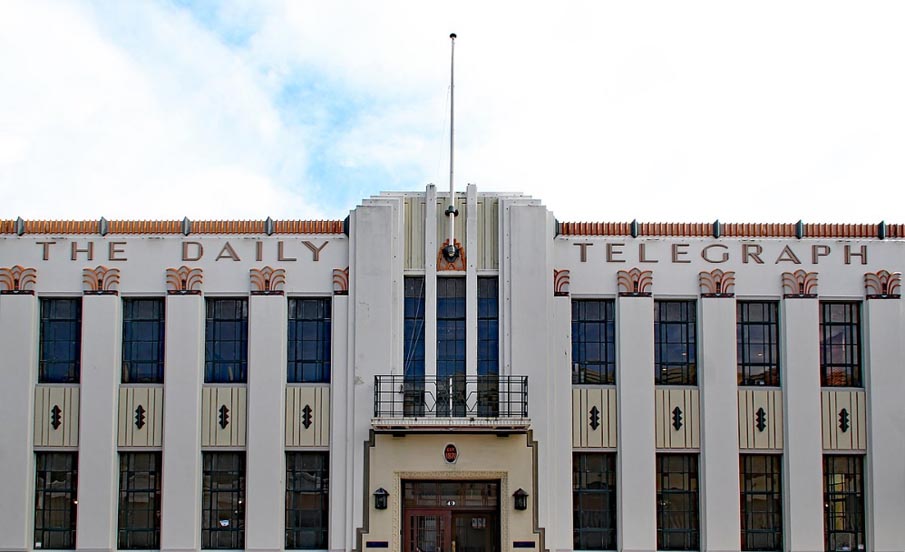The Daily Telegraph Building is considered to be one of Napier's classic Art Deco buildings. It is the third Daily Telegraph building to be built in Napier. The Daily Telegraph newspaper was established in February 1871. In 1886 a fire completely destroyed the first Daily Telegraph building as well as 25 other buildings. Within a week of the fire, work began on constructing a new premise across the road from the original building. On 3 February 1931, two days after the Daily Telegraph had celebrated its Diamond Jubilee, the second building was completely destroyed by a massive earthquake which struck the Hawke's Bay region. At 7.8 on the Richter scale, the earthquake did massive damage and is considered to be the largest natural disaster to have occurred in New Zealand in the twentieth century. A total of 258 people died. In Napier, near the centre of the quake, the earthquake and subsequent fire destroyed most of the central business district. In the days after the earthquake the Daily Telegraph continued to publish using a portion of the Ball and Ball and Company' printing works, Dalton Street. The first news bulletin was published on 4 February 1931 in conjunction with its local rival, the Daily Herald. When the Dalton Street property was declared unsafe, the paper was published from Te Awa School, and later the Vulcan Foundry in Hastings Street. Following the earthquake the Napier Borough Council delegated the task of rebuilding Napier to two government commissioners. A moratorium was placed on construction while the commissioners and the Napier Rehabilitation Committee devised a building plan for the city. Eventually the task of designing the Daily Telegraph building was given to Ernest Arthur Williams (1875-1962). Williams chose a simple Art Deco design to house the offices and printing presses. Art Deco was fashionable, suited the needs for safe construction (many Art Deco buildings were built of reinforced concrete, and the geometric designs in low relief reduced the potential risk of masonry falling off buildings during an earthquake), and economic to construct. The latter was of major concern given that the country was in the midst of the Great Depression and that, since insurance companies had ruled that the earthquake was an act of god, little or no money had been paid out. The tender to erect the building on the site of the previous building was awarded to the Fletcher Construction Company in November 1932, and the building was finished in May the following year. So as not to cause any delay in printing the, the presses were moved on the Saturday night from their temporary accommodation and were up and running in time to print the Monday edition of the paper on 8 May 1933. At the time the Daily Telegraph Building was completed it was hailed for its modernity. However, not all staff were moved into the building on completion, and the press continued to operate from the Vulcan Foundry for the next three years. In the late 1930s the newspaper began to expand to cover a greater area, and branches of the paper established throughout the Hawke's Bay. The Daily Telegraph became a popular supporter of community projects, parades, exhibitions and sports teams. In the 1960s changes were made to the building including the removal of light fittings and built in furniture, and, in the following decade, the double-storey entrance space was closed in to provide a mezzanine floor. In 1971 the 134 staff celebrated the paper's 100 years with a banquet in the War Memorial Hall. In 1982 competition for the market led to a merger with its rival of the day, the Herald Tribune, which resulted in the creation of H.B. News Ltd. The papers continued to publish under their separate names. This take-over was short lived and in 1984 H.B. News Ltd was bought by N.Z. News Ltd., the publishers of the Auckland Star. During this time the Daily Telegraph became the first newspaper in New Zealand to introduce process colour on a daily basis. N.Z. News Ltd. was eventually taken over by Wilson and Horton Ltd. The Daily Telegraph continued to publish from the building until May 1999 when it was merged with the Hawke's Bay Herald-Tribune to become Hawke's Bay Today. The building is no longer used for the production of a newspaper. The Daily Telegraph Building is one of Napier's outstanding Art Deco buildings. In addition, the building represents over one hundred years of newspaper publishing in the one location and over fifty years of publishing from the one building. The construction of the present Daily Telegraph Building, along with many other buildings, represents the resolve of Napier's citizens to rebuild their town following the devastating earthquake of February 1931. Today the building makes a handsome contribution to the townscape within the Napier City Centre Historic Area.



Location
List Entry Information
Overview
Detailed List Entry
Status
Listed
List Entry Status
Historic Place Category 1
Access
Private/No Public Access
List Number
1129
Date Entered
9th September 1989
Date of Effect
9th September 1989
City/District Council
Napier City
Region
Hawke's Bay Region
Legal description
Pt Lots 1,2 DP 503 Pt TS 128
Stay up to date with Heritage this month
